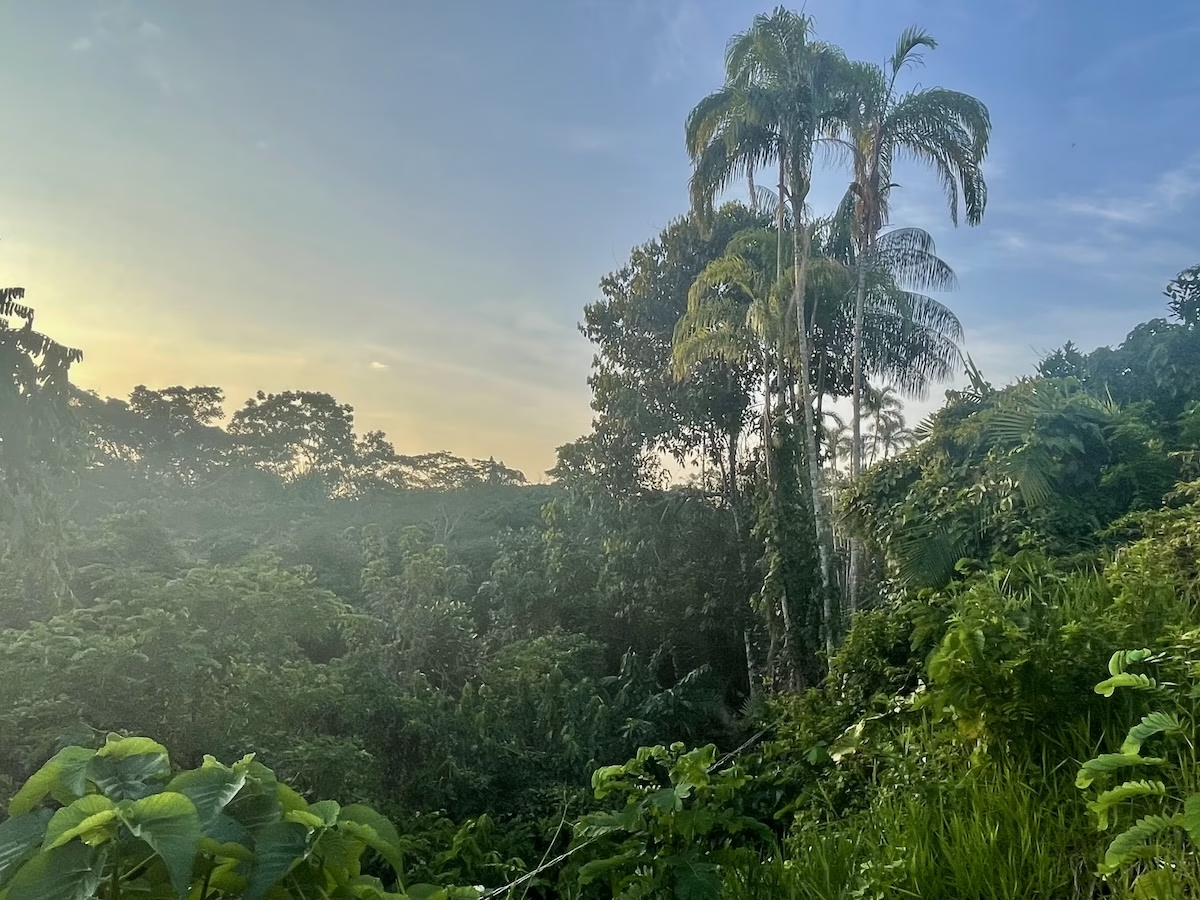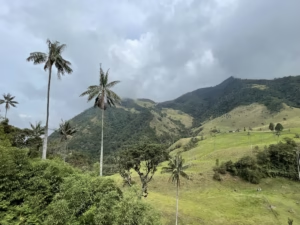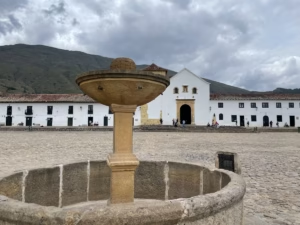The Amazon rainforest is one of the most captivating and important natural areas on the planet. While the name may have been usurped by a greedy mega-corporation, the forest itself is home to a natural bounty unequaled by almost anywhere else. It’s the world’s largest rainforest, the lungs of the planet. It’s the Amazon.
I’ve spent many an hour pouring over National Geographic articles and BBC nature documentaries about the Amazon. There was absolutely no way I was going to come to South America and not visit the Amazon. Thankfully, Leticia, Colombia’s Amazonian gateway, was only a short plane ride away. I came to Leticia with dreams of muddy waters, enormous trees, river dolphins, giant tarantulas, chattering monkeys and colorful tropical birds. I saw all those things in the Colombian Amazon.
However, what stuck with me most wasn’t the nature. It was the Amazon jungle’s humanity. The people who still live their lives in tune with the cycle of wet and dry seasons, while incorporating what they can of the modern world. It was these people who really made Leticia and the Amazon jungle such an unforgettable travel experience.
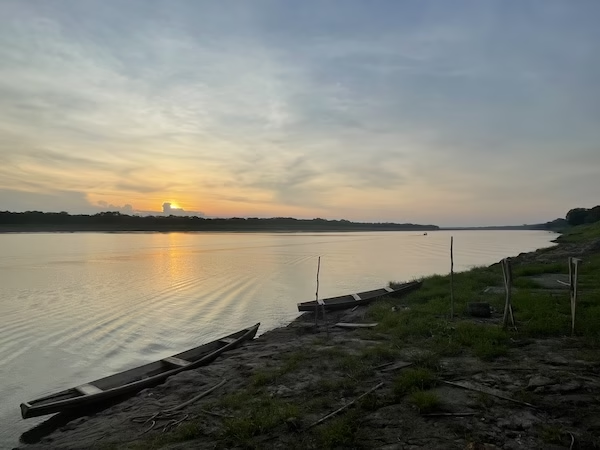
What to Know About the Amazon Rainforest
The Amazon rainforest is, of course, the largest rainforest in the world. The jungle covers over two million square miles within the borders of nine different countries, although the majority of it is in Brazil. The Amazon represents over half the world’s remaining rainforest and is the most biodiverse place on the planet.
While we mostly think of the Amazon as being wild and remote wilderness, the region is currently home to over 30 million people and 350 different ethnic groups, including an estimated 60 still uncontacted groups. People first settled in the Amazon over 11,000 years ago. They developed societies beyond just our tribal stereotypes. Recent archeological studies have discovered evidence of farms, roads and cities in the Amazon dating back 2,500 years.
In Colombia, the Amazon makes up about 35% of the country’s total territory. Most of it is dense, impenetrable rainforest. Much of that impenetrable jungle was home to guerillas and paramilitaries during the civil war, and some sections are still considered unsafe. Leticia, the capital of the Amazonas department, however, is just as safe as anywhere else.
Deforestation and climate change are the biggest issues facing the Amazon today. While countries such as Colombia and Brazil have managed to reduce the rate of deforestation in recent years, it’s still an uphill battle. And while we were visiting, heat and a drought caused by global warming caused the river to sink to dangerously low levels. Fish were literally getting stuck on the shore and cooking in the sun.
Seeing that was definitely sobering, but I choose to remain optimistic. There are still plenty of people out there fighting the good fight and trying to save the Amazon. I do try to be more conscientious of the environment in my lifestyle, and more importantly, voting and political choices. Afterall, the Amazon rainforest is the lungs of the planet. We all have a responsibility to do what we can to protect it, and our planet overall.
If you find yourself back from a trip with some extra money, why not donate it to an organization like the Rainforest Action Network that’s dedicated to protecting the earth’s tropical rainforests?
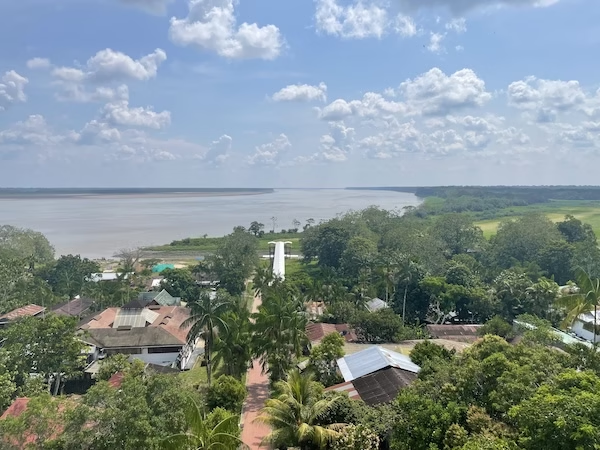
What to Pack for the Colombian Amazon
Unfortunately, I doubt my one sentence pitch in a blog post will convince anyone to donate to help the rainforest. The best way to get motivated for that is to experience the magic of the rainforest for yourself.
The good news is that adventurers heading into the modern Amazon rainforest don’t need to worry about packing crates full of gear in order to prepare for every possible scenario. While it is remote, Leticia is a modern city, with modern shops in case you forgot anything. Any jungle lodge you stay at will probably be helpful in that regard too.
However, there are a few things you should make sure you shove into your backpack if you’re planning on visiting the Amazon. First of all, it’s hot and humid, which should be obvious. You’ll need, light, loose, quick-drying clothing. I also suggest bringing moisture wicking underwear. Make sure you have long sleeves and close toed shoes to protect from insect bites and pointy jungle plants or whatever else.
When you aren’t deep in the jungle and shaded by the trees, you’ll also probably want a hat for sun protection. The tropical sun can be intense. You’ll also want a lightweight raincoat, because it’s the rainforest. Duh. Finally, be sure to bring some bug spray. Mosquitos weren’t terrible when we visited, but I’ve heard they can get scary depending on the season. In addition, you’ll want your regular travel stuff you’d bring with you anywhere. A camera, any medication, etc. etc.
Keep in mind that flights to and from Leticia are usually on smaller planes, and there may be weight restrictions. In general, you’ll have a better time if you pack as light as possible. We had everything for our trip in carry-on size backpacks and it worked out great.
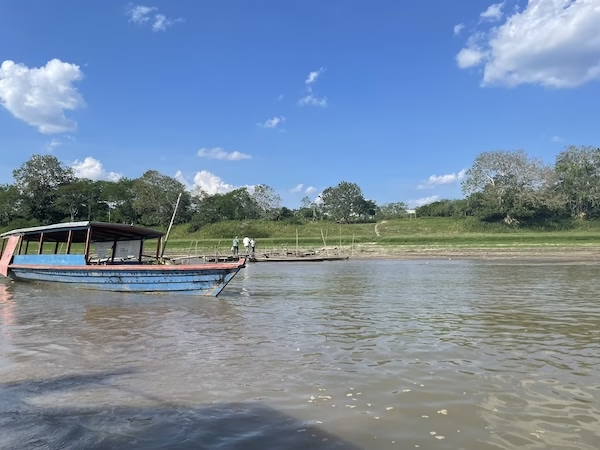
Leticia: Colombia’s gateway to the Amazon
Once you’re all packed, you’ll have to make your way to Leticia. It’s pretty much the only place to access the Colombian Amazon. Leticia might be the capital of the Amazonas department, but it feels like a rugged frontier town. That’s probably because it is a rugged frontier town.
Leticia sits on the border of Colombia, Brazil and Peru. It forms an urban metropolitan area with the Brazilian city of Tabatinga and Santa Rosa de Yavari in Peru. The borders here are fluid like the river. The three countries have an agreement that allows people to travel freely between all three cities without visas or border checks. You get the sense that people here view themselves more as Amazonian than Colombian or Peruvian or Brazilian. It’s common to meet people fluent in Spanish, Portuguese and a few indigenous languages, too.
In all these Amazonian cities, boats are a more common form of transportation than buses or cars. Houses along the river are built on wooden stilts to stay dry when the river floods. It’s a unique sort of place and unlike anywhere else I’ve ever been.
Leticia is disconnected from the rest of Colombia. There are no roads or highways here. You’ll probably have to fly. Thankfully, flights leave regularly from Bogotá and are reasonably priced. You could also, theoretically, take a boat to and from Iquitos in Peru, but that’s a journey for more adventurous souls than I.
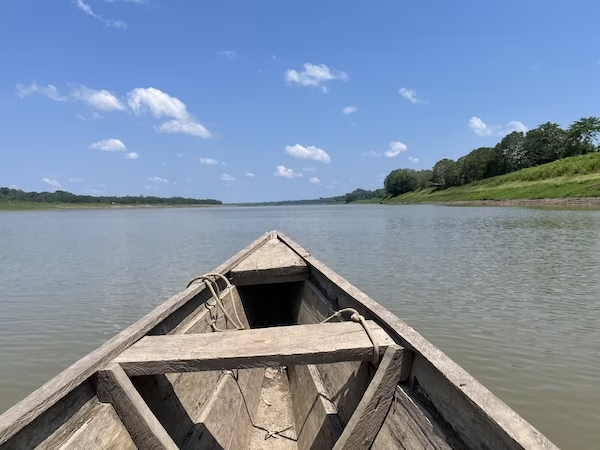
Where to Stay in Leticia
We stayed at San Jose HOUSE in Leticia. I’m not sure why they wrote “HOUSE” in all capital letters, but they did. Whatever marketing logic was behind the decision, it convinced us to stay there. Regardless of the typography, I thought San Jose HOUSE was pleasant enough and would recommend it. You can click this link to book (and help support this website at no extra cost to you.)
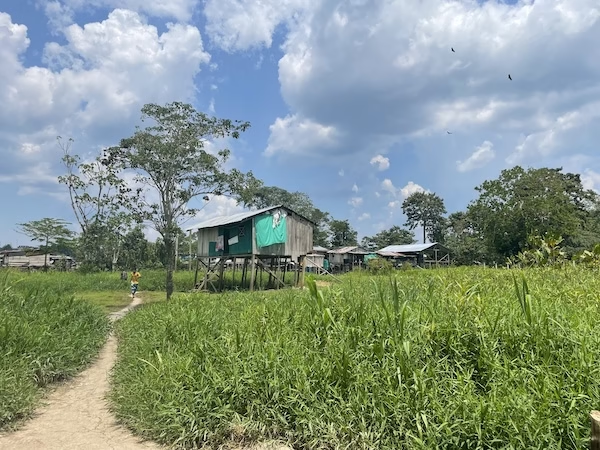
On one of the most fun, but also most stressful, aspects of travel is finding and booking places to stay. These days you have options ranging from dirt cheap hostel dorms to luxurious White Lotus style resorts. Thankfully, the internet is here to make finding accommodation easier.
Hostelworld is the go to app for finding hostels. For everything else, there’s Booking.com. If you book through either of the previous links, I’ll gain a small commission at no extra cost to you.
Things to Do in Leticia
Leticia itself has a few interesting things to do and see. As I mentioned before, the city has a rugged frontier kind of vibe to it. You might be tempted to skip Leticia and just head into the jungle, which is fine if you’re short on time. However, if you can swing it, Leticia has enough things to do to make it worth at least a couple of nights stay.
Watch the Parakeets
The absolute most amazing experience in Leticia has to be watching the parakeets roost in the central plaza. Come down to the main square, Parque Santander, in the evening, and as the sun sets, you’ll soon be surrounded by literally thousands of chattering parakeets. It’s one of the most astounding experiences I’ve ever had, especially when the birds swoop over your head.
At first, you might look at the few hundred parakeets around and think “yeah, I suppose that’s a lot of parakeets.” Just wait. Soon more will come. And more. And even more. The parakeets arrive every evening, and I promise there are more parakeets than you’ve probably ever seen in your life. It’s a pretty amazing experience.
Wear a hat, for obvious reasons.
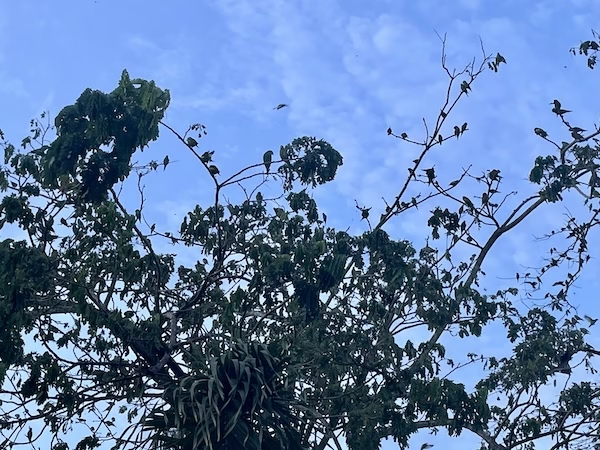
Visit the Ethnic Museum
Leticia’s Ethnographic Museum, or Museo Etnográfico de Leticia, is located just south of the main plaza and is also worth a visit. The building also houses the public library. This little public museum has displays and information about the indigenous groups that inhabit the Amazon near Leticia. Definitely a must visit for anyone interested in indigenous culture or anyone in town with some extra time on their hands.
The only downside is that the museum is quite small. The information was great, I just left wanting more. The museum is free, though, so you at least don’t feel like you’re getting ripped off.
Walk to Brazil
As I mentioned above, Colombia and Brazil (and Peru) have an agreement allowing free movement across the borders in this corner of the Amazon. While you have to hire a boat to visit Peru, the Brazilian city of Tabatinga juts right up to the edge of Leticia. You don’t need a visa or a passport, just two feet and a sense of adventure.
Head south down Carrera 6, and suddenly you’ll find all the signs are in Portuguese. We were welcomed by a group of taxi drivers who were all incredibly drunk. They were very friendly, though one had an overly strong handshake.
To be honest, I wasn’t super impressed with Tabatinga. Maybe it was just the residential area near Leticia, but I thought the Brazilian side had a bit more of a suburban feel to it. It wasn’t terrible, but it also just wasn’t all that interesting.
However, it’s worth doing just for the sake of being able to tell everyone back home that you walked to Brazil.
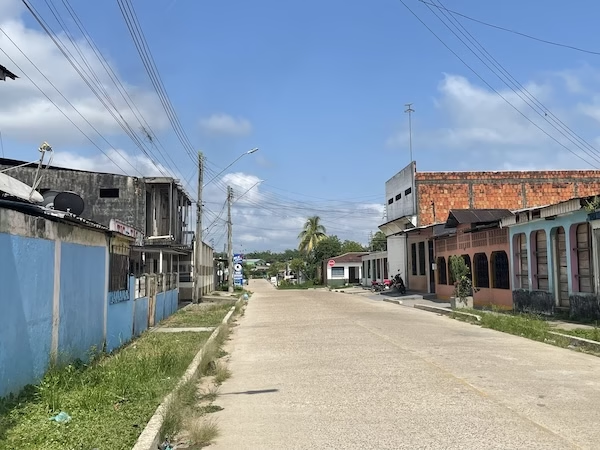
I usually like to travel and do activities independently, but sometimes you want to relax and let someone else take over. For those times, I suggest using Get Your Guide. Prices are reasonable and they have numerous tours available. Click here to explore options in Colombia. Tours booked through these links help support this blog at no extra cost to you.
Get Out of the City and Stay in the Jungle
Some people recommend staying in Leticia and just doing day trips into the jungle. I think this would be a mistake. I liked Leticia, as far as scrapy little border cities go, but there’s absolutely no reason to come all the way to the Colombian Amazon and spend all your time in town.
If you really want to experience the Amazon, you’re going to have to get out into the rainforest. Thankfully, you can do that from Leticia without too much trouble at all.
There are a number of jungle lodges around Leticia of varying price and quality. We chose to stay at the Reservea Natural Natura Park. Despite the convoluted name (and just a couple of complaints I’ll get to later) we had a fantastic time and would highly recommend it.
The Reserva Natural Natura Park is run by a very friendly local family. It has a number of comfortable, but rustic, wooden cabins built right onto the banks of the Amazon River. A boardwalk surrounds a couple of ponds filled with giant lily pads and fish. There’s also a swimming hole. The surrounding trees are filled with all sorts of Amazonian birds. In the evening, you can walk down to the dock and watch the sun set over the Amazon River itself. It’s a cool place.
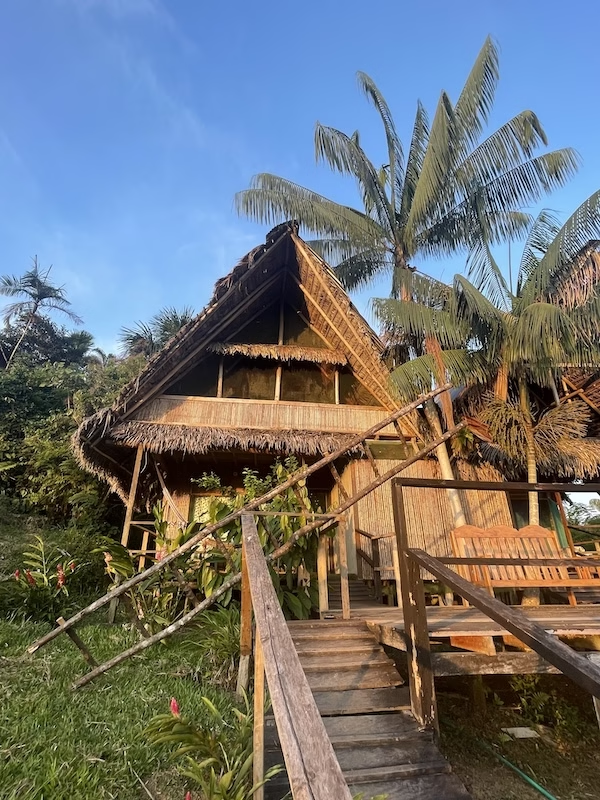
Practical Things to Know Before Staying at Reserva Natural Natura Park Lodge in the Amazon Jungle
While the reserve is beautiful, it’s also fairly isolated. There’s a small village nearby, but no stores, restaurants or services. You’ll have to rely on the lodge’s staff for food and everything else. Thankfully, the food was really good. We ate local dishes, including yucca and lots of fish caught fresh from the river.
There’s no wi-fi and no cell reception, though you might get a signal if you climb up the nearby hill. It’s also a rustic place. We had a tarantula hanging out on the ceiling of our cabin. She was nice. If you’re freaked out about insects, though, I’d say maybe a trip to the Amazon Rainforest probably isn’t for you.
The family that runs the lodge were absolutely wonderful. Their son, who was on break from school due to being unable to take the boat because of low water levels, was especially fun to hang out with. He would tell us about his life in the rainforest and scramble up trees to pick local fruit for us to try.
While the lodge is run by locals and works with the nearby village for tours and activities, it is owned by someone in Bogotá. We actually met the owner’s daughter, who ironically was terrified of all the Amazonian insects. She seemed nice enough.
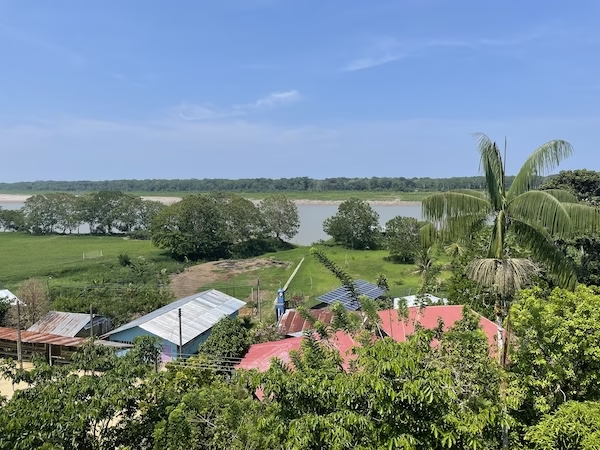
Arriving to the Nature Lodge and a Few Small Complaints
The Reserva Natural Natura Park Lodge will send you directions on how to arrive. You’ll have to come by boat from Leticia. You’ll start on the public boat, but then be dropped off at another dock where someone from the reserve will come to pick you up. It’s easier than it sounds.
Our pickup was delayed, but they had a good excuse. The lodge owns two boats, and one of them sank because it hit an underwater log due to the low river levels. It was okay, because we got to see pink river dolphins while we waited to be picked up.
My only issues were first that there wasn’t enough drinking water. They only had it for sale in little plastic baggies, which is terrible for the environment. I understand that potable water isn’t easy to get, though, and the lodge is isolated. It’s not like you can just go down and scoop drinking water from the river.
I also didn’t like the so-called “nature reserve” we visited on a tour. I’ll get into that later.
Despite these minor complaints, I’d still highly recommend Reserva Natural Natura Park. There may be other lodges that have a better record of sustainability, or are a bit more comfortable. However, I thought the value of what you get for the cost was really unbeatable. You can click one of the above links to book your stay and this site will get a small commission at no cost to you.
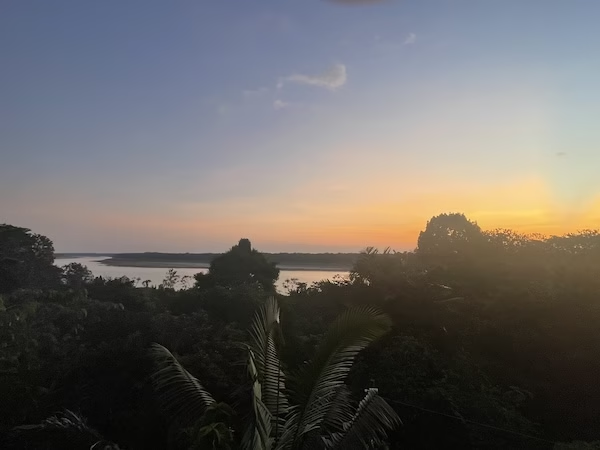
What to do in the Amazon Jungle
Activities in the Amazon Rainforest are almost all going to require a guide. Usually, I like to do things independently when I travel. However, it’s the Amazon. There are poisonous frogs, quicksand, and hungry anacondas and who knows what else lurking in the shadows of the jungle. It’s also confusing and easy to get lost. Guides are essential.
It’s also important not to forget to leave a tip for any guided tour. The guides we had were all indigenous people from the local villages. They could really use the money. Tips go a long way to support their work and help the local economy.
Of course, there’s nothing stopping you from booking a few nights at a jungle lodge and just hanging out on the porch of your cabaña all day and soaking in the sights, smells, and sounds of the world’s biggest rainforest. In fact, I’d suggest not booking too many tours and giving yourself an afternoon just for that.
But, you might as well get out and explore for a bit. I can’t speak to every possible tour in the Leticia area, but I can share my experiences about the activities we did with Reserva Natural Natura Park. With one exception, I thought they were all great.
For hikes, you’re going to need your bug spray. Our lodge provided us with rubber boots, however, for no charge. These were much appreciated on the muddy trails.
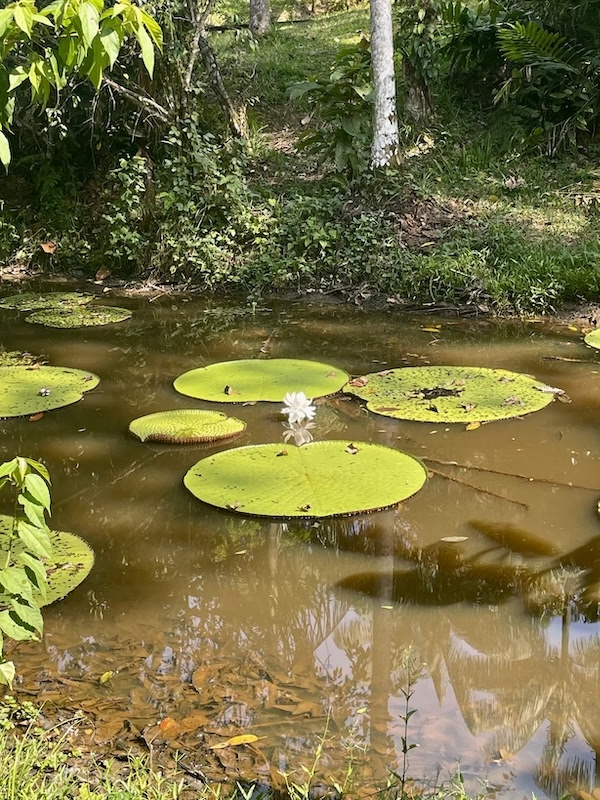
The Ceiba Hike
The first walk we took brought us to an enormous ceiba tree a short walk from the lodge. Our guide was a local villager who wore jeans a polo shirt. He was nice, but very taciturn and we walked most of the way in silence. It felt nice, though, to just be out and surrounded by such intense nature and listen to nothing but the sounds of the forest.
We walked through the muddy jungle until we reached the might ceiba tree. The ceiba is a large tree unique to the tropical Americas and West Africa. They’re pretty impressive. We’d seen them before in Costa Rica, but never as huge as in the Amazon. The local people have a legend that the river itself was formed when a giant ceiba tree fell down, it’s roots and branches forming the tributaries and branches of the Amazon River itself.
After the tree, we walked through some cassava farms to the nearby village. I forget the village’s name, but it was an interesting place. We got to meet the two village elders. They were lovely, but neither spoke English or Spanish. Apparently, they were out collecting medicinal herbs from the jungle.
We got a sense of how isolated this little village was. The only place to get a cell signal is up on top of a hill, where the village’s community center is located. This community center was once the traditional gathering and meeting point. Today it still serves that purpose, but people also come there to check their Facebook feeds.
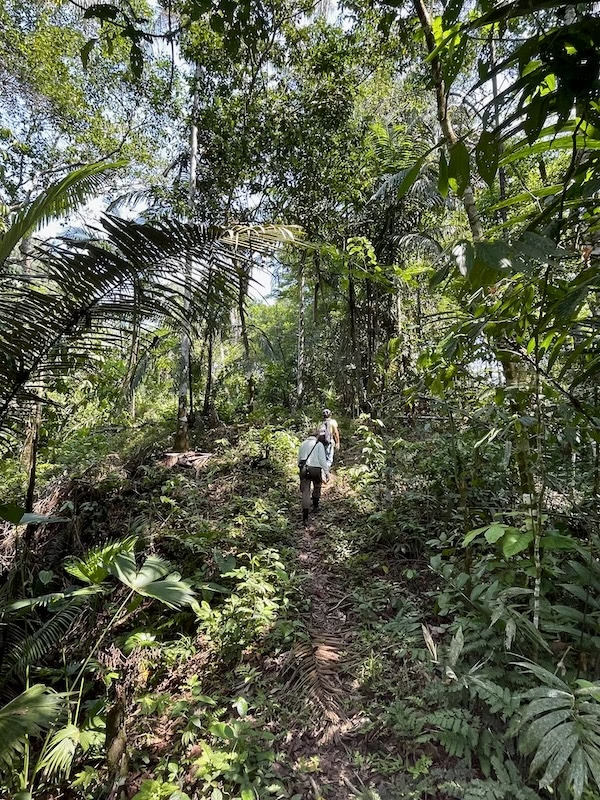
Visiting Puerto Nariño, a Ticuna Village, and a So-Called “Nature Reserve”
Initially, we were hoping to take a trip to a nearby lake to try and see some capybaras. Unfortunately, the drought was in full force during our visit, and the lake had sunk to the point that even the little wooden boats that the locals rely on wouldn’t be able to get in.
Instead, we visited the nearby town of Puerto Nariño. Puerto Nariño was a pretty nice town, though it felt a bit touristy. The whole town is only accessible by boat, and they don’t allow any cars at all, which was cool. In fact, the town’s main claim to fame is its sustainability. I mostly remember the ice cream, which was made from local fruits whose names I’ve long forgotten.
The Village of Macedonia
After Puerto Nariño, we headed to a native village called Macedonia. It seemed like it was going to be touristy as well, but it was actually pretty cool. We got to see some traditional Ticuna dancers, wearing traditional ceremonial costumes, including a kid in a monkey suit that included an enormous wooden penis.
Afterwards, there was the obligatory display of trinkets and knick-knacks for sale. I’ve heard other people complain about feeling pressured to buy things on tours, but in this case, I think it’s actually a nice way to support a local community. You’re going to buy souvenirs anyway, why not buy something hand crafted by an indigenous Ticuna villager rather than a dumb shot glass or t-shirt? I bought a bracelet.
We also stopped by a guy selling grilled worms. Apparently, these thick white grubs are a delicacy for the locals. Nobody in our group was brave enough to try the worms, until I decided “what the hell” and ordered one with salt and lime. Then everyone else had to.
To be honest, I don’t think I’m going to be rushing out to eat more Amazonian grubs. But life is about trying new things, and that was definitely something new.
Overall, the village of Macedonia was a cool experience. The people were generally pretty friendly, and those who spoke Spanish were willing to answer questions and excited to share a bit of their culture with a group of bewildered, sweaty tourists.
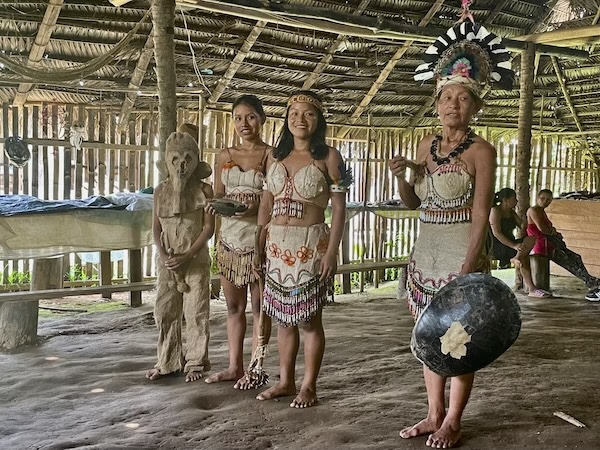
The “Nature Reserve”
The final stop, unfortunately, was a bit of a let-down for me.
We went to a so called “nature reserve” that ended up looking like it was another hotel or something. When we arrived, some of the workers started shouting “Monkey! Monkey! Monkey!” and waving bananas. I thought they were making fun of us.
But within a minute, a huge troop of squirrel monkeys rushed out of the forest and started grabbing bananas out of people’s hands. Some members of our group were really into this, but I personally felt uncomfortable. I’d been raised with strict rules regarding nature: never feed wild animals, and always keep a respectful distance. We were feeding the animals and not at all keeping any sort of distance, let alone a respectful one.
I am fully aware of the vast differences in both culture and economic means between myself and the people feeding the monkeys. I get that it’s an easy way for them to make money that they really need. It’s probably way less damaging to be feeding monkeys than to be engaged in illegal mining or ranching. I also get that those monkeys are probably semi-tame at this point, and that sort of situation is probably the only way we’d be guaranteed to see any wildlife.
Despite all that, I still didn’t feel good about it. I’m not into feeding wild animals, and it’s just not the sort of thing I want to participate in.
The Evening Anaconda Hunt
I don’t like feeding animals, and I would much rather spend time wandering in the wilderness on the off chance of seeing a cool animal in its natural environment. Especially if there’s a chance that animal might eat me.
So, of course, I jumped at the opportunity to visit an island lake known to be home to a pair of anacondas.
We started by crossing the mighty river in traditional, hand-carved wooden canoes. That activity in itself was kind of astounding. These were essentially the same style of boat that people have been using to traverse the Amazon and its many tributaries for thousands of years. People once relied on these canoes for hunting, fishing and transportation. Now those same canoes were carrying a group of over-privileged tourists.
We disembarked on the cracked dry mud shores of an island. Another victim of the drought. Then we hiked into the forest, past mighty trees that towered overhead, and smaller trees that looked as though they could be home to a tiny witch.
We reached the lake where the anacondas lived as the sun began to set. It was one of the greatest sunsets I’ve ever seen in my life. Others in our group, though, were starting to get worried. We’re talking about anacondas, afterall.
“Anacondas don’t really attack people, do they?” I asked the guide.
“Yes, of course they do,” he said, and we all suddenly felt very exposed standing in the jungle as the light faded.
“What do you do if one attacks?”
“There’s a shaman in the village who can scare them away.”
We all had the same questions. How far away was this shaman, exactly? And how were we supposed to get a hold of him in a place with no cell reception?

The Journey Back Under the Stars
After the sun set, we hiked back through the jungle in the dark, going as fast as we dared to keep up with our guide’s flashlight. Phantom anacondas lurked in every shadow. Unfortunately, or maybe fortunately, however, we never saw any real anacondas.
We returned to the hand-carved canoes laying on the cracked dry mud and slid back into the river. The black water flowed past, potentially hiding giant snakes, but probably not.
About halfway across, the flashlights went out. We were suddenly surrounded by darkness. Nothing by the dark river below us and the twinkling stars splattered across the night sky above us. As we sat there, floating on the Amazon River in under the stars, it suddenly hit me. Here I was sitting on the world’s longest river, in the middle of the world’s longest rainforest, staring up into the universe. I felt a moment of connectedness that I’d failed to find in hours of online meditation apps. It was a moment I still think about.
This was where I felt the magic of the Amazon stir something deep within my soul. And I don’t even believe in magic or souls.
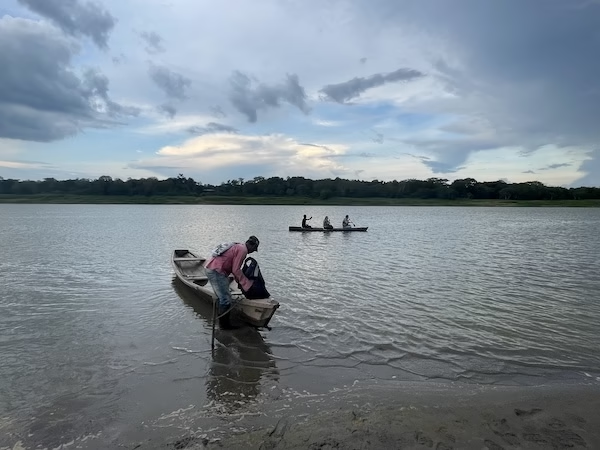
Final Thoughts on the Amazon
We left our little cabaña and the Reserva Natural Natura Park the next morning, taking the boat back to Leticia. I felt changed somehow, but I still don’t know if I can fully identify exactly how. In the evening, we watched the parakeets roost in the square and had dinner with a group of young Italian gynecologists. And then we got on a plane and flew back, out of the misty rainforest of the Amazon to the familiar, modern world.
I’d gone to Leticia expecting an experience similar to something I might have seen in National Geographic articles or BBC nature documentaries.
Instead, in and around Leticia, I found a world that was much more interesting. A world where people wear jeans and polo shirts and check their social media feeds and go to work and school just like everyone else. They drink beer and live and have the same hopes and dreams as anyone.
But the people in the Colombian Amazon also still live their lives with the ebb and flow of the river. They take boats to school instead of school buses, and they plant yucca and pick medicinal herbs from the forest. They cross between nations with as little concern for borders as the flowing water.
And if an anaconda attacks, they send the local shaman a text.
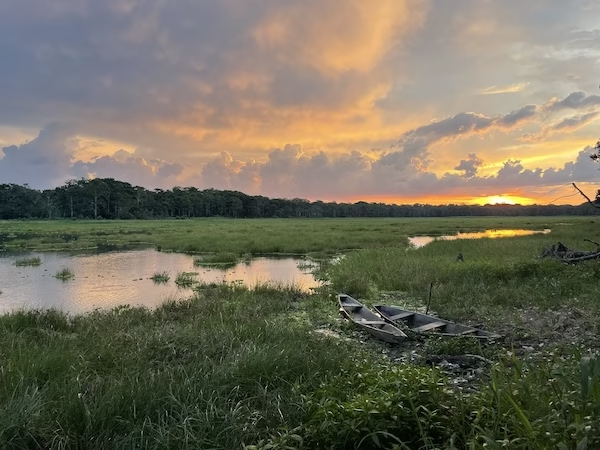
Want more tropical adventures in Colombia? Read our guide here: Covering Ground in Colombia: A Travel Guide to One of the World’s Most Magical Countries
Useful Websites for Traveling Colombia
As much as we might long for the days when you could show up to a town with nothing more than a beat-up guidebook and a sense of adventure, today much of traveling involves being glued to our phones making bookings. I’ve compiled some helpful apps and websites below that at least help make those bookings more convenient so you can spend less time staring at your phone and more time exploring at your surroundings. Some of these sites are affiliate links that give me a small commission at no cost to you if you chose to book through them. All of them are sites I’ve used personally and have no problem recommending.
Just be sure to do your due diligence as much as possible. Only hire local guides and try as much as possible to stay in locally owned hotels and hostels so that your hard earned travel dollars actually go to support the local economies of the places you visit.
Booking.com is basically the world’s only hotel booking website. They have hotels, guesthouses and vacation rentals all over Colombia.
Hostelworld is the go-to site for booking hostels. If dorm rooms and shared bathrooms are your thing, you’ll find hostels all over Colombia.
Get Your Guide offers tours and activities all around the world. Unlike some other sites and apps that do the same thing, you can actually find some reasonably priced deals here.
Red Bus is a super useful resource for booking long distance buses throughout Colombia. If only you could use the app to turn down the air conditioning on the night buses…
Cabify is the best way to book a taxi in Colombia’s major cities. It works like Uber, but you get connected to a licensed, authorized, taxi instead of just some random weirdo.

